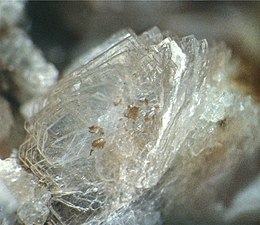| Tumchaite | |
|---|---|
 | |
| General | |
| Category | Phyllosilicate |
| Formula (repeating unit) | Na2(Zr,Sn)Si4O11·H2O |
| IMA symbol | Tum[1] |
| Crystal system | Monoclinic |
| Crystal class | Prismatic (2/m) (same H-M symbol) |
| Space group | P21/c |
| Unit cell | a = 9.144 Å, b = 8.818 Å c = 7.537 Å, β = 113.22°; Z = 2 |
| Identification | |
| Formula mass | 462.51 g/mol |
| Color | Colorless to white |
| Crystal habit | Prismatic, tabular, massive, granular |
| Twinning | on {100} |
| Cleavage | Perfect on {100} |
| Fracture | Uneven |
| Tenacity | Brittle |
| Mohs scale hardness | Close to 4.5 |
| Luster | Vitreous |
| Streak | Colorless to white |
| Diaphaneity | Translucent to transparent |
| Specific gravity | 2.78 |
| Optical properties | Biaxial (-) |
| Refractive index | nα = 1.570, nβ = 1.588, nγ = 1.594 |
| Birefringence | δ = 0.0240 |
| Pleochroism | Colorless to greenish-gray |
| 2V angle | 60 (5)° |
| Ultraviolet fluorescence | None |
| Solubility | Does not dissolve with dilute HCl |
| References | [2][3][4][5] |
Tumchaite, Na2(Zr,Sn)Si4O11·H2O, is a colorless to white monoclinic phyllosilicate mineral. It is associated with calcite, dolomite, and pyrite in the late dolomite-calcite carbonatites. It can be transparent to translucent; has a vitreous luster; and has perfect cleavage on {100}. Its hardness is 4.5, between fluorite and apatite. Tumchaite is isotypic with penkvilksite. The structure of the mineral is identified by silicate sheets parallel {100}, formed by alternation of clockwise and counterclockwise growing spiral chains of corner-sharing SiO4 tetrahedra. Tumchaite is named for the river Tumcha near Vuoriyarvi massif.[4]
- ^ Warr, L.N. (2021). "IMA–CNMNC approved mineral symbols". Mineralogical Magazine. 85 (3): 291–320. Bibcode:2021MinM...85..291W. doi:10.1180/mgm.2021.43. S2CID 235729616.
- ^ "Tumchaite". www.mindat.org. Retrieved 2015-12-02.
- ^ "Tumchaite Mineral Data". www.webmineral.com. Retrieved 2015-12-02.
- ^ a b Subbotin, V. V.; et., al. "Tumchaite Na2(Zr,Sn)Si4O11.H2O - A new mineral from carbonatites of the Vuoriyarvi alkali-ultrabasic massif, Murmansk Region, Russia" (PDF). The American Mineralogist. 85: 1516–1520. doi:10.2138/am-2000-1024. S2CID 53325912.
- ^ Mineralienatlas